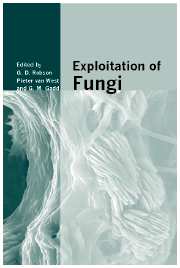Book contents
- Frontmatter
- Contents
- List of contributors
- Preface
- I Comparative and functional fungal genomics
- II Bioactive molecules
- III Protein folding and secretion
- 7 The role of microtubules and motors for polarized growth of filamentous fungi
- 8 The cellular response to protein unfolding stress
- 9 Protein secretion and associated stresses in Aspergillus: a genomic perspective
- IV Fungal bioremediation
- V Fungal biocontrol of pests
- Index
- References
7 - The role of microtubules and motors for polarized growth of filamentous fungi
from III - Protein folding and secretion
Published online by Cambridge University Press: 05 October 2013
- Frontmatter
- Contents
- List of contributors
- Preface
- I Comparative and functional fungal genomics
- II Bioactive molecules
- III Protein folding and secretion
- 7 The role of microtubules and motors for polarized growth of filamentous fungi
- 8 The cellular response to protein unfolding stress
- 9 Protein secretion and associated stresses in Aspergillus: a genomic perspective
- IV Fungal bioremediation
- V Fungal biocontrol of pests
- Index
- References
Summary
Introduction
Polarized growth is the mechanism by which filamentous fungi extend their hyphae. Microtubules (MT) and filamentous actin (F-actin), in combination with their corresponding motor proteins, kinesins, dynein and myosins, play crucial roles in this process. The exact contribution of the MT cytoskeleton, however, is still under debate. In this review we will summarize recent advances in understanding the role of MTs and MT-dependent motor proteins in fungi with special emphasis on Aspergillus nidulans. Genetic, biochemical and cell biological approaches in A. nidulans and other fungi led to a modified view of many aspects within the past few years. There is increasing evidence that MT strings, which are visualized by immunostaining or GFP-tagging, consist of several MTs and their dynamics appears to be different in fast-growing hyphal tips as compared with young germlings. Whereas the spindle pole bodies were considered as the only or the main microtubule organizing centres (MTOCs) in filamentous fungi, it appears that several additional MTOCs are responsible for the generation of the MT array. In addition to new insights into the MT network and its dynamics, the roles of several kinesins have been elucidated recently and their interplay with dynein investigated. It became clear that MT functions are interwoven with those of the actin cytoskeleton and that three main structures are required for polarized growth, the Spitzenkörper (vesicle supply centre), the polarisome and probably cell end markers at the cortex. We propose a model for polarized growth, where the actin cytoskeleton and the polarisome are crucial for hyphal extension and the MT cytoskeleton continuously provides the building material within vesicles to the Spitzenkörper and determines growth directionality by delivery of cell end marker proteins.
- Type
- Chapter
- Information
- Exploitation of Fungi , pp. 95 - 116Publisher: Cambridge University PressPrint publication year: 2007
References
- 1
- Cited by



